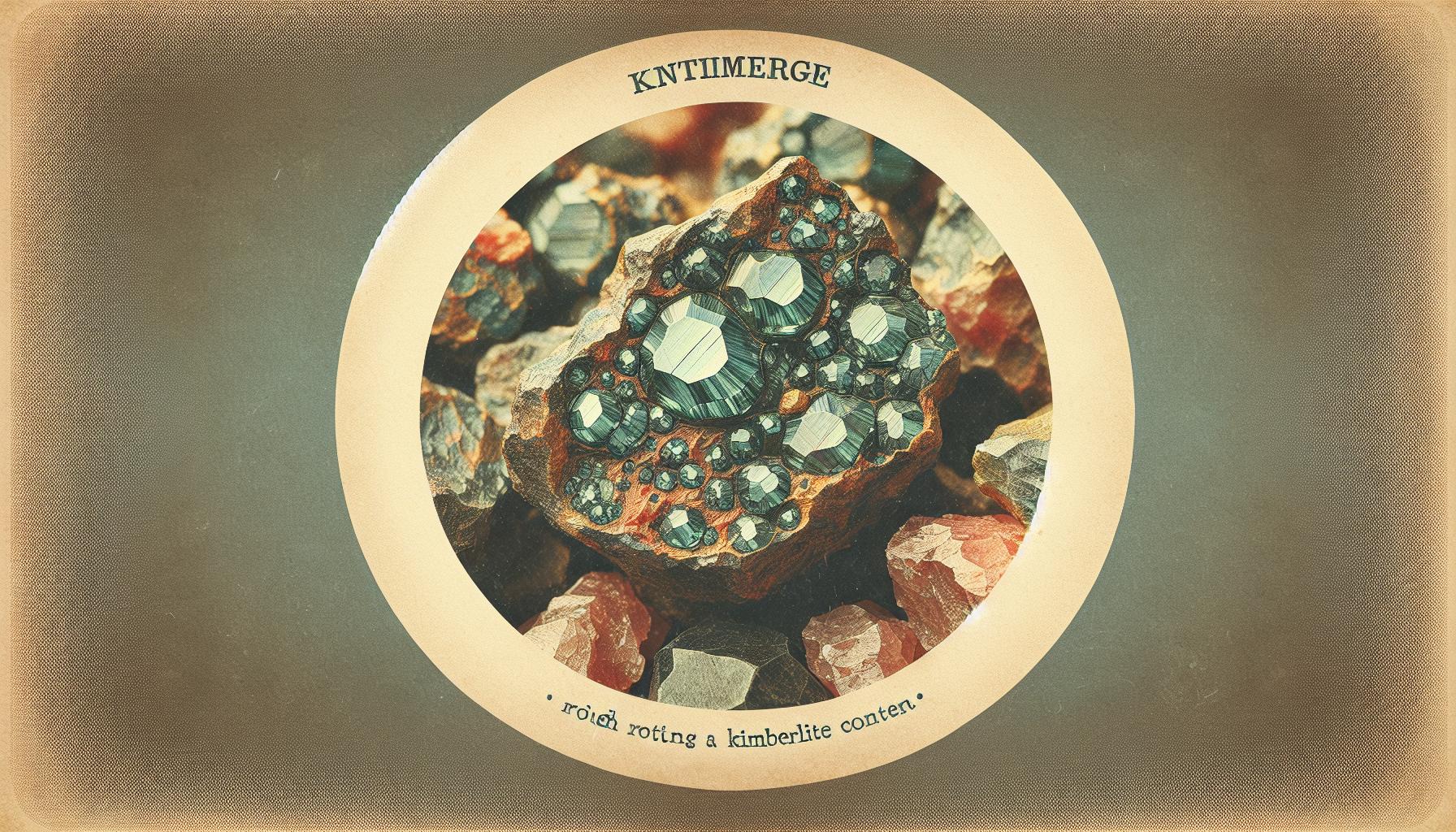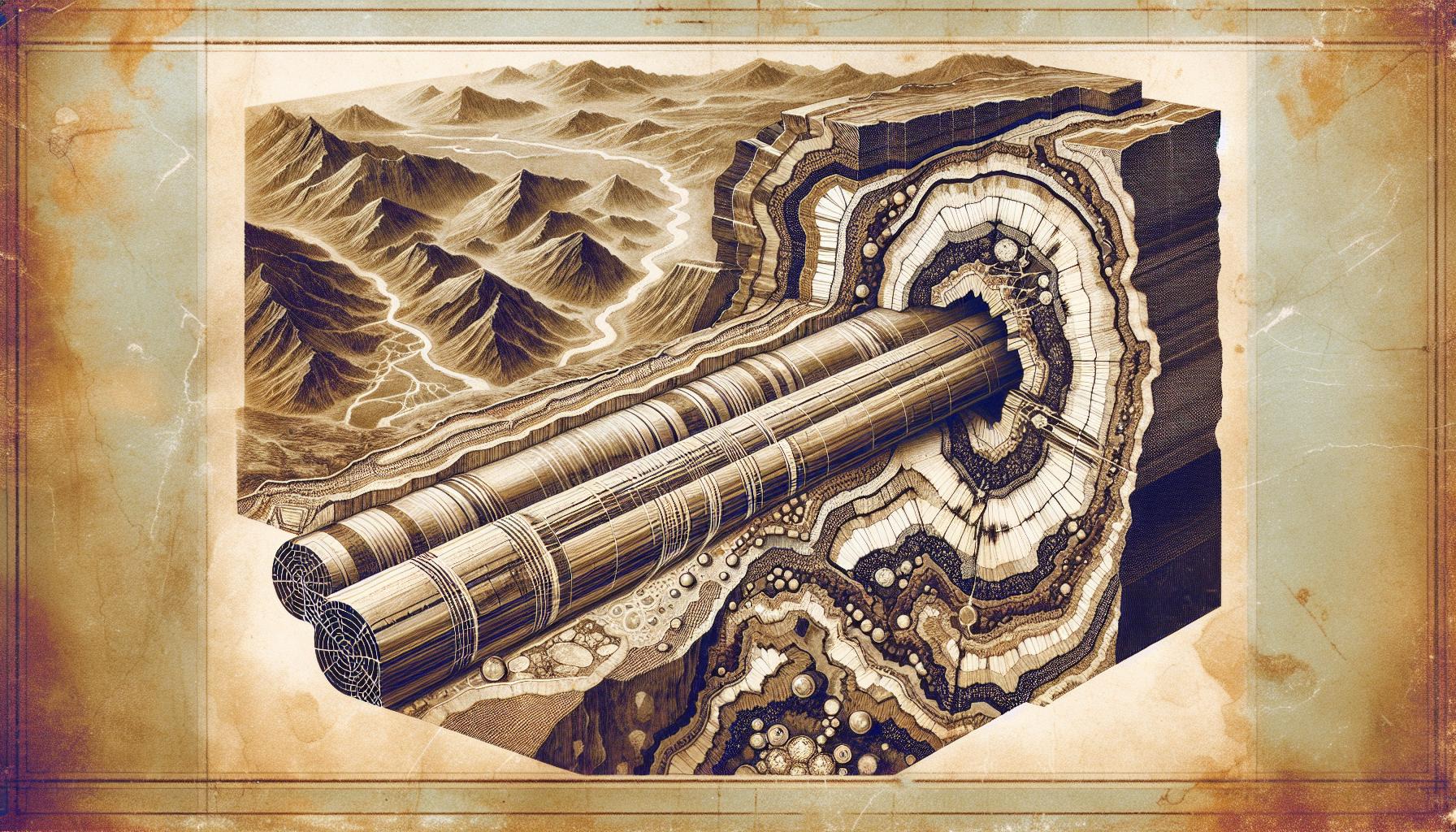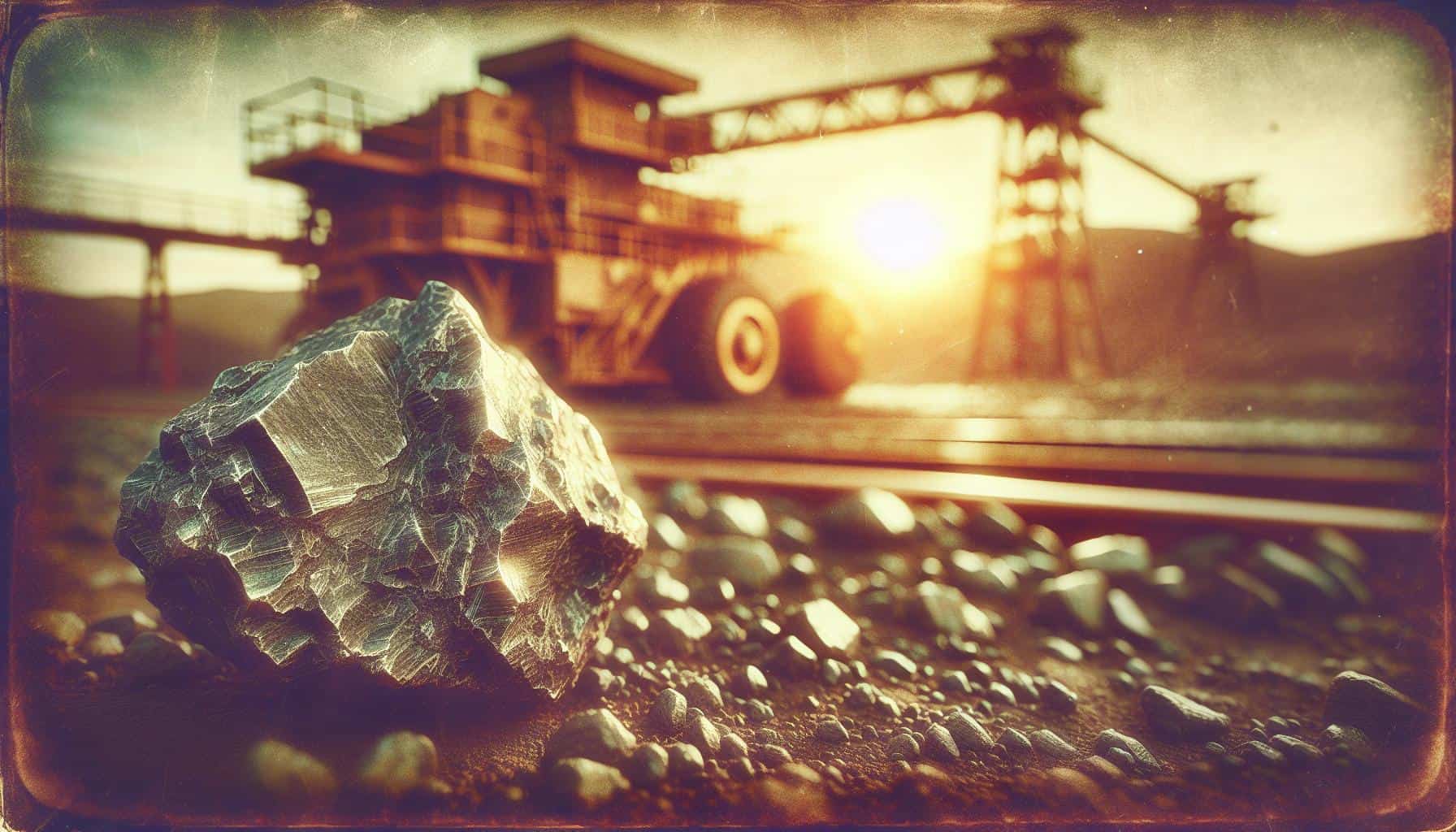Ever wondered about the value of kimberlite, the volcanic rock that’s the primary source of diamonds?
Your curiosity isn’t misplaced—kimberlite’s worth isn’t just in its potential to house these precious gems. While it’s not as flashy as the diamonds it may contain, kimberlite has its own unique value in the world of geology and mining.
Determining the value of kimberlite involves more than just a glance at its surface. It’s a complex interplay of rarity, location, and the potential yield of diamonds.
Stick around to uncover the factors that influence kimberlite’s price tag and why it’s sought after by diamond hunters and geologists alike.
Kimberlite, a volcanic rock, is valued for potential diamond content and geological information. Rarity, diamond yield, and location are key value factors. Not all kimberlite contains diamonds; its worth varies based on these attributes.
What Is Kimberlite?
Kimberlite is a type of igneous rock that captures the imagination of diamond hunters around the world. It forms deep within the Earth’s mantle and is shot to the surface through volcanic pipes. Uniquely associated with diamonds, these rocks can offer clues to the vast mineral riches that lie beneath our feet.
Understanding kimberlite begins with its composition. Kimberlite typically contains olivine, phlogopite, pyroxenes, and occasionally, you’ll find garnets. The magic, however, lies in its capacity to carry diamonds from the high-pressure environments deep within the Earth up to more accessible depths. Diamonds are stable at high pressures, and kimberlite acts as a vessel for their journey upward.
Location is key for kimberlite deposits. Most are found in regions with old stable cratons, such as parts of Africa, Russia, and Canada. These are areas where the geological conditions were just right for kimberlite formation billions of years ago.
When exploring the worth of kimberlite, it’s crucial to mention that not all kimberlite pipes contain diamonds, and not all diamonds are of gem quality. For every ton of kimberlite mined, a very small percentage will yield something precious. Hence, the pursuit of kimberlite is as much a numbers game as it is one of geological insight.
The exploration for kimberlite involves extensive geological surveys, sampling, and sometimes just a bit of luck. Your understanding of the Earth’s history, technological advancements in mining, and the allure of finding the next big diamond deposit all play a role in the kimberlite quest.
In mining operations, kimberlite is processed to extract diamonds, but the rock itself can also provide valuable geological information. It reveals the conditions deep within Earth and helps scientists understand the processes that shape our planet. For this reason, even without diamonds, kimberlite holds value for the scientific community.
By measuring the proportion of various minerals and analyzing the rock’s structure, geologists can piece together the history of our planet’s evolution. The study of kimberlite supports theories about continental drift, mantle composition, and the very origins of these elusive stones.
Kimberlite Prices: Factors That Affect Value

When you’re trying to understand the worth of kimberlite, it’s crucial to consider multiple factors that have a direct impact on its value. Similar to evaluating precious gemstones, certain attributes significantly influence the pricing of kimberlite.
Color, Clarity, and Cut Quality
Kimberlite itself is typically not assessed for beauty like diamonds. However, these elements become critically important when the rock includes diamond. The value is significantly dictated by the quality of any diamonds present within the kimberlite.
- Color: Diamonds in the hue range from colorless to light yellow or brown command higher prices.
- Clarity: Clear diamonds or ones with few inclusions are more desirable and can boost the value of the kimberlite.
- Cut Quality: A well-cut diamond reflects light better, resulting in increased sparkle and, consequently, more substantial value.
While these factors are less about the kimberlite and more about the diamonds it may contain, they’re essential to consider as the presence of high-quality diamonds can make a specific source of kimberlite exceptionally valuable.
Market Demand and Availability
The value of kimberlite is also closely tied to its rarity and the demand within the market.
Kimberlite’s unique status as a primary source for diamonds means that its value goes beyond mere esthetics—it represents potential. Consequently, areas where diamondiferous kimberlite pipes are abundant could see a dip in prices due to increased availability.
On the other hand, regions where these pipes are scarce could drive up kimberlite prices. Factors that influence market demand and availability include:
- Geological survey results indicating the presence of diamond-bearing kimberlite
- Political stability in the regions where kimberlite is found
- Alterations in international trade laws affecting the supply chain
- Technological advancements improving mining efficiency
As you look at current trends, keep in mind that the value of kimberlite is as dynamic as the market itself. With shifting factors like these, the worth of a kimberlite deposit can fluctuate over time, making it a speculative venture for potential investors.
Understanding Kimberlite: A Rare Gem

The Rarity of Kimberlite
Kimberlite’s value hinges on its rarity. Not every geological formation yields kimberlite, and not all kimberlite contains diamonds. Often hidden deep within the Earth’s mantle, significant deposits are discovered sporadically and usually in remote locations. The chances of stumbling upon a kimberlite pipe with enough diamond concentration to be economically viable are slim, making it an elusive prize for miners and investors alike.
Moreover, the age of kimberlite formations is staggering. Most were formed more than 70 million to 1.5 billion years ago, causing the majority to lie dormant, waiting to be unearthed. This immense timeframe adds layers of complexity to the search and extraction process.
Origins and Characteristics
Kimberlite’s origin story begins beneath the Earth’s surface. This igneous rock is formed in the mantle and is shot towards the surface through volcanic activity, creating what geologists call kimberlite pipes. These pipes are the most significant source of diamonds, but kimberlite itself is not precious until it’s proven to contain them.
A deep understanding of kimberlite’s characteristics is crucial. It typically appears in two forms – the hard, blue ground that’s found deeper and is more challenging to mine, and the yellow ground closer to the surface, which is weathered and easier to extract. Additional attributes of kimberlite include:
- A distinct texture: coarse-grained and often contains crystals of olivine, phlogopite, and other minerals.
- Host rock: aside from housing diamonds, it includes a range of mineral indicators like garnets and chrome diopsides, which signal diamond presence.
Assessing the potential value of a kimberlite deposit involves detailed analysis of its aspects – from color and texture to its precise mineral content. Each characteristic provides clues about the potential quality and quantity of diamonds lodged within. The deeper the origin and the richer the content, the more substantial the worth of the kimberlite your dealing with.
Kimberlite Grading and Valuation
The Grading System for Kimberlite
When it comes to determining the value of kimberlite, you’ll need to understand the nuances of its grading system. Kimberlite grading is a meticulous process that assesses several factors, which are critical in ascertaining the worth of both the rock and the diamonds it may contain. Key attributes observed during grading include the rock’s texture, color, and the crystal form of the minerals within.
These elements provide vital information on the quality of diamonds the kimberlite could yield. For instance, a high presence of indicator minerals like olivine, garnet, and picroilmenite suggests a richer diamond content. The grading system categorizes kimberlite deposits into different classes, informing mining companies about the viability and potential return on investment of the mining operation.
Certification and Appraisal
Before you invest in a kimberlite deposit or stake your claim, the rock must go through a professional Certification and Appraisal process. This assessment is not only about estimating value but also about credibility. Certified kimberlite graders analyze the samples to generate a detailed report, which serves as an authoritative guide on the quality and value you might expect from the excavation.
The appraisal process involves high-tech equipment and expert analysts with profound understanding of geology and gemology. Certified reports are essential, especially when you’re looking to attract investment or partnership in mining ventures as they lend authenticity and assurance to the estimated worth. In addition, they can also provide insights into potential environmental impact and extraction difficulties, factors that are increasingly important in the mining industry.
Remember, the value of kimberlite goes beyond its potential diamond yield; it’s also an indicator of the geological history of our planet, making it a subject of scientific value and curiosity. Keep these considerations in mind while navigating the complex, yet exciting, realm of kimberlite valuation.
Current Market Trends in Kimberlite Pricing
When you’re delving into the market dynamics of kimberlite, it’s imperative to understand that pricing is inherently volatile. Kimberlite doesn’t have a universally fixed price; market trends fluctuate based on supply and demand, mining output, and global economic conditions. In the diamond industry, particularly, recent years have seen a shift with an increased emphasis on ethical mining practices and sustainability, factors that now play a crucial role in evaluating a kimberlite’s worth.
Notably, the demand for diamonds and, by extension, for kimberlite housing these gems tends to rise in times of economic prosperity and falls during downturns. This correlation makes tracking the general economic indicators crucial for those invested in the future of kimberlite valuation. One should also keep in mind that advancements in mining technology can affect kimberlite pricing. More efficient methods can lower mining costs, potentially reducing prices, while they can also enable access to previously uneconomical deposits.
Current trends in the industry show an inclination towards the certification of diamond mines as a response to consumer demands for responsibly sourced diamonds. This trend has led to certain certified kimberlite sources commanding higher prices due to their verified ethical and sustainable extraction processes. Investors are increasingly aware of the reputational risks associated with non-certified sources, often reflecting in the market valuation of such deposits.
Analysts observe that emerging markets are becoming progressively important in driving the demand for diamonds. As wealth grows in these regions, so does the potential for a surge in kimberlite prices, provided the deposits meet the increasing expectations for quality and ethical standards. The integration of such markets into the global economy could lead to greater stability in pricing as the customer base expands beyond traditional strongholds.
For investors and mining operations, keeping a finger on the pulse of these trends is non-negotiable. By aligning their strategies with current market tendencies, stakeholders in the kimberlite industry can better navigate the complex landscape of valuation and maximize their returns without compromising on ethical practices. Understanding these nuances ensures that you’re not just following the market—you’re anticipating its next move.
The Most Expensive Kimberlite
When you’re exploring the value of kimberlite, it’s fascinating to delve into the record-breaking instances of this volcanic rock. The most expensive kimberlite is that which is densely populated with high-grade diamonds. High-grade refers to diamonds of exceptional quality and clarity, and these finds can catapult the value of a kimberlite deposit significantly. Such instances are incredibly rare and can turn an ordinary mining operation into a worldwide sensation almost overnight.
Specific geographic regions have gained a reputation for their potential to house premium-quality kimberlite deposits. The Siberian region of Russia, parts of Botswana, and the Canadian Arctic are known for their lucrative findings. For example, the renowned Mir mine in Russia is one of the deepest mines in the world and was once the most productive diamond mine globally, due to the richness of its kimberlite pipe.
- Geographical Location – Countries with stable economies and robust infrastructure often report higher-value kimberlite.
- Diamond Content – The concentration and quality of diamonds within the kimberlite play a critical role.
- Mining Accessibility – The ease with which mining operations can access the deposits factors into the overall costs and, consequently, the value of the extracted kimberlite.
Market variables, such as the cost of rough diamonds, directly correlate with the value of kimberlite. When prices for rough diamonds spike, so does the perceived worth of diamond-rich kimberlite formations. Additionally, the association with luxury brands can increase demand for diamonds from certain mines, thereby pushing the value even higher. For example, diamonds that end up in the showcases of high-end jewelers like Tiffany & Co. or Graff carry premium prices, often making the originating kimberlite of greater value.
The gems found within top-tier kimberlite are not just sold based on carat weight but also on their historical and symbolic significance. Some diamonds unearthed from the rarest kimberlite have outsized reputations, making them sought after by collectors and connoisseurs, enhancing the overall worth of such deposits.
Buying Kimberlite: Tips and Recommendations
Where to Purchase High-Quality Kimberlite
When you’re in the market for kimberlite, it’s essential to source it from reputable suppliers known for quality. Typically, this includes mining companies, specialized dealers, and sometimes through direct transactions at gem and mineral shows. Research is key to ensuring you connect with legitimate sellers. Visiting trade shows enables you to engage directly with industry experts and view the kimberlite firsthand.
Online marketplaces have become increasingly popular for purchasing kimberlite. However, the convenience comes with a caveat: you need to be vigilant about verifying the credibility of sellers and the authenticity of their products. Always check customer reviews, seller history, and ask for documentation when possible.
Opt for sellers who provide a clear traceability path of their kimberlite, ensuring it’s ethically sourced and complies with environmental standards. If you’re investing in larger quantities or high-grade kimberlite, consider working closely with geologists or valuation specialists who can help you navigate the intricacies of the market.
Ensuring Authenticity and Value
The authenticity and value of kimberlite are paramount in your purchasing decision. Before committing to any transaction, insist on receiving certification and appraisal documents. These should come from accredited labs or graders, attesting to the kimberlite’s mineral composition, potential diamond content, and overall quality.
One practical tip is to request a detailed report that includes information about the stone’s origin, geological history, and any treatments it may have undergone. Be aware that untreated, natural kimberlite with a clear history will generally have a higher value than stones that were processed or enhanced.
When assessing value, consider not only the current market and historical data but also any future projections that might impact the worth of your kimberlite. Stay informed about global economic trends, advancements in diamond extraction technology, and shifts in consumer demand. By being well-versed in these areas, you’re positioned to make knowledgeable investments with confidence.
Conclusion: Buying & Selling Kimberlite
Unearthing the true value of kimberlite requires a blend of knowledge and diligence.
You’ve learned that its worth hinges on a spectrum of factors from rarity to the quality of the stones it may harbor. Remember, securing an accurate appraisal and certification is crucial when determining its value. Staying abreast of market fluctuations will also guide you in making informed decisions.
Whether you’re investing or simply fascinated by this volcanic rock, you now have the insights to navigate the kimberlite market with confidence.







